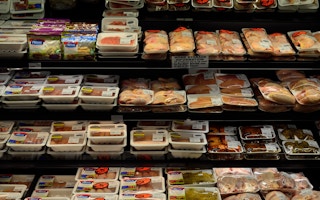“Beat Plastic Pollution” was heard everywhere this year on World Environment Day, calling for consumers, businesses and government to avoid the use of plastic.
Cheap and durable, plastic and its role in everyday life have come under the spotlight after numerous reports revealed that the non-biodegradable material now contaminates food and drinking water.
Of all the plastic used, packaging accounts for 39.9 per cent, beating the next highest category—consumer and household goods—by a whole 17.5 percentage points.
“Sometimes food packaging becomes a scapegoat of the whole environmental movement,” says Onat Bayratkar, vice-president of Sealed Air Food Care.
Food manufacturers have come under fire for the excessive use of packaging as momentum against plastic picked up speed around the world, from bananas to Easter Eggs.
But can the packaging industry be part of the solution, rather than part of the problem?
“
It is imperative that consumers and producers alike understand its value as a resource, and move towards recycling.
Karl Deily, president, Sealed Air Food Care
While acknowledging the risk that plastic poses, Bayratkar points out that food safety cannot be compromised and there are no viable alternatives on the market that can preserve food freshness the way plastic can just yet. As such, plastic is unlikely to be completely phased out entirely in the near future.
“On the one hand if you don’t have the proper packaging, the health and food safety [issues] come into the picture, but on the other, the environmental costs are also very significant. It’s a balance,” he says.
The company that brought the world bubble wrap and Cryovac, food packaging that uses vacuum technology to shrink or wrap its contents, Sealed Air is working on more environmentally friendly products that can shrink the amount of plastic used.
The latest is a bio-based food packaging which uses renewable resins from high-amylose corn starch, a biodegradable material with film-forming properties. Not only does it protect its contents against oxygen, it is now cost competitive with traditional non-renewable plastic films.
This new material will be used to package perishable foods such as poultry and seafood in North America and Mexico.
However, “it’s not an end-all solution, because you can’t use it by itself,” admits president of Sealed Air Food Care Karl Deily. Sensitive to moisture, the bio-based material has to be used with a protective layer that is non-biodegradable.
On top of reducing the use of non-biodegradable materials, the US-headquartered packaging giant has also tried to move away from single-use plastics to ensure that their material serves more than just storage purposes.
“We try to make packaging more functional. For example, one can cook, refrigerate, pasteurise or apply high pressure to the product in the material. The product can also be re-heated and eaten out of the package,” explains president of Sealed Air Food Care Karl Deily.
The next best step for the packaging industry
With plastic unlikely to be dislodged as a packaging material anytime soon, Deily says that it is imperative that consumers and producers alike understand its value as a resource, and move towards recycling.
“If [oxo-biodegradable materials] are not part of the solution, then it has to be recyclable or reusable,” says Deily.
As part of its commitment to sustainability, Sealed Air has developed materials that are made of recycled resins and are also more conducive for post-consumer recycling. “Literally all plastic, even if it’s a complex multi-layer material, can be recycled,” he says.
“Europe has become very efficient at [recycling] certain products. The recycled resins that are available on the market are actually purer than virgin, and are more economically viable. But that’s because they have developed the infrastructure to do that over the years. Not every country has that,” he adds.
Deily emphasises the need for governments to ensure that they are investing in proper infrastructure to make recycling the norm. “It can be very confusing for a consumer to know what to do with the product, and [the question is] do you have the infrastructure to recycle the product and to use the recycled materials?” he asks.
To date, less than one-fifth of all plastic is recycled globally, while the rest ends up in landfills and oceans. In Singapore, the numbers are even more drastic—only 6 per cent is recycled.
Having tried everything from bamboo shoots to beets as packaging alternatives, Deily and Bayratkar conclude that much more has to be done. “There’s no perfect solution [to packaging], that’s why we have an integrated diverse set of innovations and we are still looking for more,” says Deily.

















